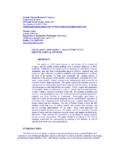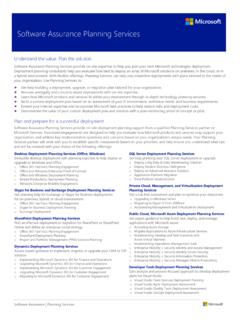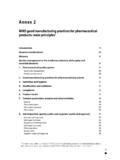Transcription of Annex 9 Guidelines on packaging for …
1 119 World Health OrganizationWHO Technical Report Series, No. 902, 2002 Annex 9 Guidelines on packaging for pharmaceuticalproductsIntroductory of of and , relabelling and inserts for patients (patient information leaflets) of of materials and of or types of assurance aspects of and of of the in The international for dosage form requirements for containers in Europe, Japanand the Standards145 References145 Bibliography147 Appendix 1 Storage areas150 Appendix 2 Labels151 Appendix 3 Self-inspection and quality audits152 Appendix 4 International Standards on packaging154 Introductory noteThis review of the various elements of the packaging of a pharmaceu-tical product is aimed at ensuring that medicines arrive safely in thehands of the patients for whom they are the manufacture of pharmaceutical products, quality assurance isdefined as the totality of the arrangements made with the object ofensuring that pharmaceutical products are of the quality required fortheir intended use (1).
2 In addition, the system of quality assurance for the manufacture ofpharmaceutical products should ensure that arrangements are madefor the manufacture, supply and use of the correct starting and pack-aging materials (1).Public opinion sometimes considers packaging to be , it must be emphasized that packaging preserves the stabil-ity and quality of medicinal products and protects them against allforms of spoilage and medicinal products need to be protected and consequently needto be packaged in containers that conform to prescribed standards,particularly with respect to the exclusion of moisture and light and theprevention of leaching of extractable substances into the contents andof chemical interaction with the contents.. However, the limits ofacceptability in these various respects depend, at least in part, onclimatic variables. Recommendations in The international pharmaco-poeia can only be advisory; precise quantitative standards will have tobe locally determined (2).
3 121 The complexity of packaging materials and the highly technologicalnature of medicinal products is such that manufacturers are con-fronted with significant problems. Interaction between packaging andsuch products is possible due to the combination of a multiplicity ofcontainer components and active pharmaceutical ingredients, excipi-ents and solvents used in a variety of dosage quality of the packaging of pharmaceutical products plays a veryimportant role in the quality of such products. It must: protect against all adverse external influences that can alter theproperties of the product , moisture, light, oxygen and tem-perature variations; protect against biological contamination; protect against physical damage; carry the correct information and identification of the kind of packaging and the materials used must be chosen in sucha way that: the packaging itself does not have an adverse effect on the product ( through chemical reactions, leaching of packaging materialsor absorption); the product does not have an adverse effect on the packaging ,changing its properties or affecting its protective resulting requirements must be met throughout the whole of theintended shelf-life of the product .
4 Given the link between the qualityof a pharmaceutical product and the quality of its packaging , phar-maceutical packaging materials and systems must be subject, inprinciple, to the same quality assurance requirements as pharmaceu-tical appropriate system of quality assurance for the manufacture ofpharmaceutical products should therefore follow the WHO guide-lines for good manufacturing practices (GMP) (1).The requirements to be met by pharmaceutical packaging and pack-aging materials as described in compendia (pharmacopoeias) andstandards ( those of the International Organization for Standard-ization (ISO)) must be considered only as general in character. Thesuitability of packaging or packaging material for any particularrequirements and conditions can only be ascertained through detailedpackaging and stability studies on the product definitions given below apply specifically to the terms used inthese Guidelines .
5 They may have different meanings in other productAny product that has completed all the processing stages up to, butnot including, final packaging (1).containersA container for pharmaceutical use is an article which holds or isintended to contain and protect a drug and is or may be in directcontact with it. The closure is a part of the container. The containerand its closure must not interact physically or chemically with thesubstance within in any way that would alter its quality. The followingterms include general requirements for the permeability of containers(3): Well-closed containers must protect the contents from extraneousmatter or from loss of the substance under normal conditions ofhandling, shipment or storage. Tightly closed containers must protect the contents from extraneousmatter, from loss of the substance, and from efflorescence, deli-quescence or evaporation under normal conditions of handling,shipment or storage.
6 If the container is intended to be opened onseveral occasions, it must be designed to be airtight after reclosure. Hermetically closed containers must protect the contents from ex-traneous matter and from loss of the substance, and be imperviousto air or any other gas under normal conditions of handling, ship-ment or and dosage forms requiring protection from light shouldbe maintained in a light-resistant container that either by reason ofthe inherent properties of the material of which it is composed, orbecause a special coating has been applied to it shields the contentsfrom the effects of light. Alternatively, the container may be placedinside a suitable light-resistant (opaque) covering and/or stored in adark place (3).labelsAll finished drug products should be identified by labelling, asrequired by the national legislation, bearing at least the followinginformation:(a) the name of the drug product ;(b) a list of the active ingredients (if applicable, with the Interna-tional Nonproprietary Names (INNs)), showing the amount of123each present, and a statement of the net contents, number ofdosage units, mass or volume;(c) the batch number assigned by the manufacturer;(d) the expiry date in an uncoded form;(e) any special storage conditions or handling precautions that maybe necessary;(f) the directions for use, and any warnings and precautions that maybe necessary.
7 (g) the name and address of the manufacturer or the company orperson responsible for placing the product on the authorization ( product licence, registration certificate)A legal document issued by the competent drug regulatory authoritythat establishes the detailed composition and formulation of the prod-uct and the pharmacopoeial or other recognized specifications ofits ingredients and of the final product itself, and includes details ofpackaging, information given on the label, product information andshelf-life (1).materialsA term used to denote starting materials, process aids, intermediates,active pharmaceutical ingredients, packaging and labelling materialAny material, including printed material, employed in the packagingof a pharmaceutical product , excluding any outer packaging used fortransportation or shipment. Primary packaging materials are thosethat are in direct contact with the product (1). packaging processAll operations, including filling and labelling, that a bulk product hasto undergo in order to become a finished product (1).
8 ProductionAll operations involved in the preparation of a pharmaceutical prod-uct, from receipt of the starting materials, through processing andpackaging, to completion of the finished product (1).quarantineThe status of starting or packaging materials, intermediates, or bulkor finished products isolated physically or by other effective meanswhile a decision is awaited on their release, rejection or reprocessing(1).124 Containers for pharmaceuticals1ampouleA container sealed by fusion and to be opened exclusively by break-ing. The contents are intended for use on one occasion container consisting of surfaces, whether or not with a flat bottom,made of flexible material, closed at the bottom and at the sides bysealing; the top may be closed by fusion of the material, depending onthe intended multi-dose container consisting of two layers, of which one isshaped to contain the individual doses. Strips are container with a more or less pronounced neck and usually a container, usually cylindrical, suitable for liquid or solid pharma-ceutical dosage forms; generally for use in a specially designed appa-ratus ( a prefilled syringe).
9 Gas cylinderA container, usually cylindrical, suitable for compressed, liquefied ordissolved gas, fitted with a device to regulate the spontaneous outflowof gas at atmospheric pressure and room needleA hollow needle with a locking device intended for the administrationof liquid pharmaceutical dosage syringeA cylindrical device with a cannula-like nozzle, with or without a fixedneedle and a movable piston, used for the administration, usuallyparenteral, of an accurately measured quantity of a liquid pharmaceu-tical form. The syringe may be prefilled, and can be for single-dose ormulti-dose on a list of terms drawn up in response to a request from the EuropeanCommission to revise and replace the Guidelines of the Committee for ProprietaryMedicinal Preparations (III/3593/91).125pressurized containerA container suitable for compressed, liquefied or dissolved gas fittedwith a device that, after its actuation, produces a controlled spon-taneous release of the contents at atmospheric pressure and containerA container for single doses of solid, semi-solid or liquid multi-dose container consisting of two layers, usually provided withperforations, suitable for containing single doses of solid or semi-solidpreparations.
10 Blisters are container for multi-dose semi-solid pharmaceutical forms consist-ing of collapsible material; the contents are released via a nozzle bysqueezing the small container for parenteral medicinal products, with a stopperand overseal; the contents are removed after piercing the single-dose and multi-dose types of considerationsPackaging may be defined as the collection of different components( bottle, vial, closure, cap, ampoule, blister) which surround thepharmaceutical product from the time of production until its aspects of packaging to be considered (4) include: the functions of packaging ; the selection of a packaging material; the testing of the material selected; filling and assembling; sterilization; storage and materials (see section 2) include printed material em-ployed in the packaging of a pharmaceutical product , but not anyouter packaging used for transportation or shipment. Examples of thetypes of materials used are shown in Table distinction must be made between primary and secondary packag-ing components.















